Did you know that Palau, a small island nation in the western Pacific Ocean, is home to an astonishing array of sacred natural sites and biodiversity? This paradise boasts a remarkable statistic – the Palau National Marine Sanctuary covers a staggering 80% of the country’s national waters, equivalent to 475,077 square kilometers! This extraordinary commitment to environmental preservation and sustainable development showcases Palau’s dedication to protecting its natural heritage and fostering a thriving ecosystem.
Key Takeaways:
- Palau is home to sacred natural sites and a diverse range of biodiversity.
- The Palau National Marine Sanctuary covers 80% of Palau’s national waters.
- Palau’s conservation efforts exemplify its commitment to environmental protection.
- The sustainable development of Palau’s ecosystems is a key focus.
- Palau serves as a beacon for other nations in terms of biodiversity conservation.
Palau National Marine Sanctuary
The Palau National Marine Sanctuary is a remarkable example of marine conservation and sustainable fishing practices. Spanning an expansive 475,077 square kilometers, it is one of the world’s largest fully protected marine areas. This sanctuary envelops Palau’s captivating archipelago, including over 500 islands, and is renowned for its biodiversity and natural beauty.
The Palau National Marine Sanctuary is a marine protected area (MPA) that safeguards a significant portion of Palau’s exclusive economic zone (EEZ). Approximately 80% of the country’s national waters fall under the sanctuary’s purview, strictly prohibiting extractive activities such as fishing and mining. By designating this extensive area as a marine protected zone, Palau prioritizes the preservation of marine biodiversity and the conservation of delicate ecosystems.
Within the sanctuary, locally managed fisheries are permitted in the remaining 20% of Palau’s exclusive economic zone. This approach ensures sustainable fishing practices that contribute to both food security and the maintenance of stable livelihoods for Palauans. By establishing a balanced system that protects areas while still allowing for responsible fishing, Palau demonstrates its commitment to promote sustainable and thriving marine ecosystems.
Promoting marine biodiversity conservation is a primary objective of the Palau National Marine Sanctuary. This diverse ecosystem is home to a staggering variety of marine life, including an abundance of coral reefs and an extensive array of marine species. These protected habitats provide essential breeding grounds, nurseries, and foraging areas for numerous marine organisms, supporting the overall health and resilience of the marine environment.
“The Palau National Marine Sanctuary serves as a living testament to Palau’s commitment to environmental sustainability and responsible stewardship of its natural resources.” – President Tommy Remengesau Jr.
Sustainable fishing practices play a crucial role within the Palau National Marine Sanctuary. By implementing science-based fisheries management strategies, Palau strives to maintain fish populations at sustainable levels, ensuring their long-term viability. This approach not only benefits the marine ecosystem but also supports the local fishing industry, protecting it from overexploitation.
To visually appreciate the beauty of the Palau National Marine Sanctuary, here is an image of the incredible marine life that thrives within its protected boundaries:
Through the effective management of the Palau National Marine Sanctuary, Palau sets a global example for marine conservation and sustainable fishing practices. By prioritizing the preservation of marine biodiversity and sustaining the delicate balance of its ecosystems, Palau showcases its commitment to both environmental protection and the well-being of its people.
Endemic Species of Palau
Palau is a biodiversity hotspot, boasting a unique array of endemic species that cannot be found anywhere else in the world. These extraordinary plants and birds are intricately woven into the ecological fabric of Palau’s diverse ecosystems, making their conservation efforts paramount.
The endangered plant species in Palau, such as the Daucifolium Spleenwort and Numularis Cycad, are particularly vulnerable to habitat loss and the adverse impacts of climate change. The delicate balance of their existence hangs in the balance, warranting urgent protective measures.
Conservation efforts are crucial for preserving these endangered plant species and safeguarding their genetic diversity for future generations. By addressing the root causes of habitat loss and implementing effective climate change mitigation strategies, we can protect these remarkable species and bolster Palau’s remarkable biodiversity.
Palau is also home to fascinating endemic bird species, including the critically endangered Palau Megapode. These remarkable birds face multiple threats, including the destructive forces of climate change and the ferocity of typhoons.
Preserving the habitats where these endemic bird species thrive is vital to their survival. By safeguarding their nesting grounds and implementing effective conservation measures, we can ensure the continued existence of these magnificent birds.
Conservation and Preservation
Palau’s commitment to the conservation of its endemic species is unwavering. Collaborative efforts between governmental organizations, conservationists, and local communities actively work towards protecting Palau’s unique biodiversity.
Through the establishment of protected areas and the implementation of conservation programs, Palau strives to safeguard the habitats essential for the survival of endemic species. These initiatives not only focus on preserving individual species but also on maintaining the intricate web of interactions that exist within Palau’s ecosystems.
Conservation efforts encompass habitat restoration, invasive species management, and awareness campaigns aimed at engaging the local population and visitors alike. By fostering a sense of stewardship and collective responsibility, Palau hopes to create a sustainable future where endemic species thrive.
The Palau Tree Snail: A Remarkable Example
One exceptional endemic species that deserves special mention is the Palau Tree Snail. These unique creatures, known for their vibrant shells and slow movements, are a testament to the remarkable biodiversity found in Palau.
To highlight the significance of the Palau Tree Snail in Palau’s ecosystem, let’s take a closer look:
| Species |
Scientific Name |
Status |
| Palau Tree Snail |
Partula sp. |
Endangered |
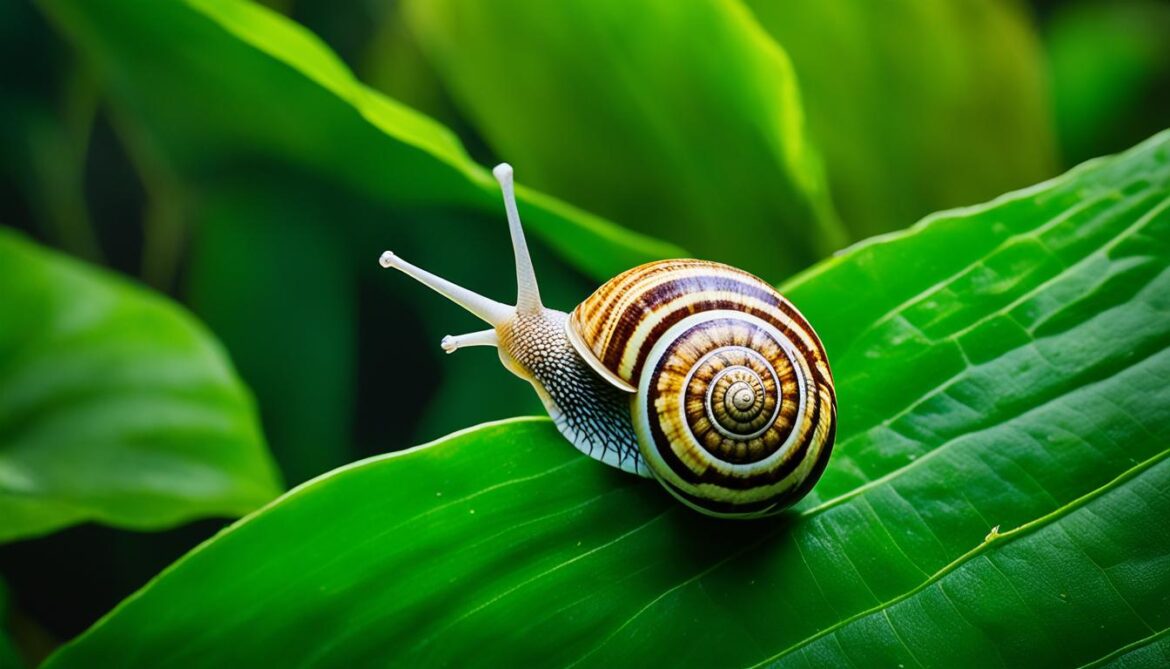
The Palau Tree Snail, classified as endangered, is an integral part of Palau’s ecosystem. These snails play a significant role in seed dispersal and are crucial for maintaining a healthy and balanced environment. Furthermore, they contribute to the overall biodiversity of Palau, making them a valuable indicator species for environmental health monitoring.
Efforts are underway to protect the Palau Tree Snail and its habitat, emphasizing the importance of preserving this iconic endemic species. By raising awareness and implementing effective conservation strategies, Palau aims to secure a future where the Palau Tree Snail and other endemic species flourish.
Marine Biodiversity of Palau
Palau’s marine environment is a haven of diversity, boasting over 400 species of hard corals, 300 species of soft corals, and an impressive array of more than 1,500 species of reef fish. The crystal-clear waters of Palau’s Rock Island Southern Lagoon, a designated World Heritage Site, reveal the wonders of the underwater world, including vibrant coral reefs teeming with life.
The coral reefs of Palau are not only visually stunning but also vital ecosystems that support a vast array of marine species. These reefs act as nurseries for many fish species, providing shelter, food, and breeding grounds. The intricate interplay between corals, reef fish, and other marine organisms creates a delicate and harmonious balance.
To protect this precious marine biodiversity, Palau has implemented robust marine conservation initiatives. Conservation efforts focus on preserving pristine coral reefs, promoting sustainable fishing practices, and raising awareness about the importance of marine conservation.
“The health and vibrancy of Palau’s marine ecosystems depend on the preservation of its coral reefs and the sustainable management of its marine resources. We must act now to safeguard these invaluable treasures for future generations.” – Palauan Marine Conservation Officer
Palau’s commitment to marine conservation extends beyond traditional approaches. The country implements strict regulations to ensure sustainable fishing practices that maintain fish populations and protect the delicate balance of the marine ecosystem. By promoting sustainable fishing methods such as catch limits and enforcing no-take zones, Palau strives to preserve the abundance and diversity of reef fish species.
Palau also recognizes the importance of responsible tourism in marine conservation. Through education and outreach programs, visitors are encouraged to appreciate and respect the marine environment, ensuring that their activities have minimal impact on the fragile ecosystems. Diving and snorkeling tours are conducted in an environmentally conscious manner, with strict adherence to guidelines that protect the reefs from damage.
Community involvement plays a crucial role in Palau’s marine conservation efforts. The Palauan government works closely with local communities to develop sustainable fishing practices and empower indigenous communities to actively participate in conservation initiatives. By engaging the local population in the management and protection of their natural resources, Palau ensures the long-term sustainability of its marine biodiversity.
Preserving Palau’s Marine Biodiversity
Palau is committed to the preservation and sustainable use of its marine biodiversity, recognizing its ecological, economic, and cultural significance. Through a combination of strict regulations, responsible tourism, and community involvement, Palau is setting an example for marine conservation globally.
By safeguarding the health of its coral reefs, protecting reef fish populations, and promoting sustainable fishing practices, Palau is taking tangible steps to ensure the longevity and resilience of its marine ecosystems.
Through these collaborative efforts, Palau is not only conserving its own marine biodiversity but also making a significant impact on global marine conservation. As visitors from around the world come to witness the majesty of Palau’s underwater world, they are inspired by the country’s dedication to preserving this natural wonder, spreading the message of marine conservation far and wide.
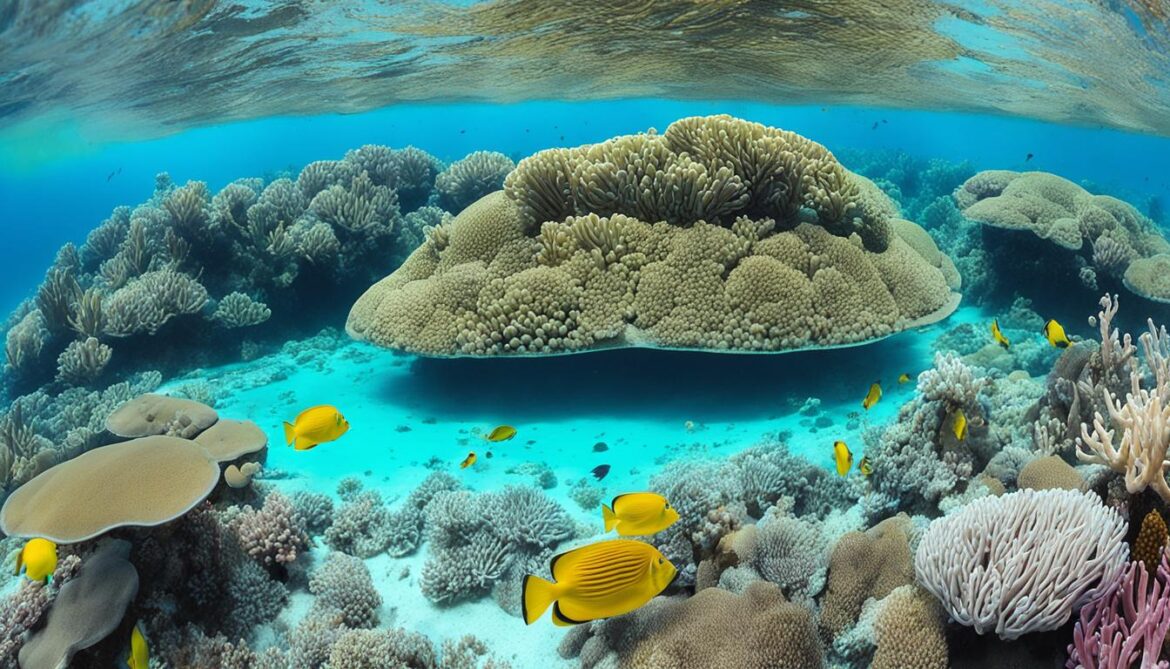
Terrestrial Biodiversity of Palau
Palau boasts a diverse array of flora and fauna within its terrestrial ecosystems. These habitats support a remarkable range of plant and animal species, contributing to Palau’s unique biodiversity. In fact, approximately 20% of the plant species found in Palau are endemic, meaning they are exclusive to the region. These endemic plants play a vital role in maintaining the ecological balance and overall health of Palau’s terrestrial ecosystems.
However, the endemic plants of Palau face significant threats to their survival. Habitat loss, primarily due to human activities such as deforestation and urbanization, poses a major risk to these species. Additionally, the introduction of invasive species further exacerbates the challenges faced by endemic plants, as they struggle to compete for resources and adapt to changing conditions.
One notable example of an endemic species in Palau is the Palau Tree Snail. This unique snail species, Palaina albata, is found exclusively within Palau’s dense forests. Unfortunately, the Palau Tree Snail is classified as endangered. The combination of habitat loss and predation by invasive species has led to a significant decline in its population. Conservation efforts are crucial to ensuring the survival of the Palau Tree Snail and other endangered species in the region.
Palau’s terrestrial biodiversity is a treasure that requires our utmost attention and protection. By conserving these unique ecosystems and implementing measures to mitigate threats, we can safeguard the future of Palau’s endemic plants and endangered species.”
Efforts to preserve Palau’s terrestrial biodiversity involve initiatives such as habitat restoration, invasive species management, and education programs to raise awareness about the importance of biodiversity conservation. Through these conservation endeavors, Palau aims to maintain the delicate balance of its terrestrial ecosystems and secure a sustainable future for its plant and animal populations.
The Importance of Endemic Species Conservation
Conserving Palau’s endemic plant species is of paramount importance for several reasons. Firstly, endemic plants play a crucial role in preserving the overall biodiversity of the region. As unique species found nowhere else in the world, they contribute to the richness and distinctiveness of Palau’s natural heritage.
Furthermore, endemic plants often have intricate ecological relationships with other organisms in their native ecosystems. They provide food and habitat for a variety of animal species, including endangered birds like the Palaina albata. By protecting endemic plants, we can also safeguard the habitats and survival of these associated animal species.
Moreover, Palau’s endemic plants may possess undiscovered medicinal properties or other useful traits. Preserving these species offers the potential for future scientific and economic benefits, making their conservation a matter of both environmental and societal importance.
By prioritizing the protection and preservation of Palau’s terrestrial biodiversity, we can ensure that future generations have the chance to experience and benefit from the unique flora and fauna that make Palau truly exceptional.
| Threats to Endemic Plants in Palau |
Impact on Endangered Species |
| Habitat loss due to deforestation and urbanization |
Potential extinction and loss of genetic diversity |
| Invasive species competition and predation |
Decline in population and loss of habitats |
| Climate change and shifting environmental conditions |
Disruption of ecological relationships and need for adaptation |

As seen in the table above, Palau’s endemic plant species face numerous threats that impact their survival. By understanding these challenges and implementing effective conservation strategies, we can work towards preserving Palau’s terrestrial biodiversity for future generations. Together, we can protect Palau’s endemic plants, endangered species, and the delicate ecosystems that make this island nation a natural treasure.
Threats to Palau Biodiversity
Palau’s exceptional biodiversity faces numerous challenges that threaten its delicate ecosystems and unique species. These threats include climate change, rising sea levels, habitat destruction, pollution, and urbanization. Each of these factors contributes to the degradation and loss of Palau’s natural heritage and must be urgently addressed for the preservation of its biodiversity.
Climate Change and Rising Sea Levels
One of the most significant threats to Palau’s biodiversity is climate change. Rising global temperatures result in the warming of oceans, leading to coral bleaching and the loss of vital marine habitats. Additionally, climate change contributes to the intensification of tropical typhoons, resulting in coastal erosion, habitat destruction, and the displacement of species. Rising sea levels further exacerbate these impacts, submerging low-lying coastal areas and altering Palau’s coastal ecosystems.
Habitat Destruction
The destruction of natural habitats is another major threat to Palau’s biodiversity. Urbanization and infrastructure development encroach upon pristine forests, wetlands, and coastal areas, leading to habitat fragmentation and the displacement of species. The loss of critical habitat areas disrupts the ecological balance and further contributes to the decline of vulnerable species. Conservation efforts must focus on protecting and restoring these habitats to ensure the survival of Palau’s diverse flora and fauna.
Pollution
Pollution, particularly marine pollution, poses a significant threat to Palau’s biodiversity. Runoff from agricultural activities and improper waste management result in the contamination of rivers, coastal waters, and coral reefs. Harmful pollutants, such as sediment, nutrients, and chemicals, degrade water quality and disrupt marine ecosystems. Efforts to reduce pollution and promote sustainable waste management practices are crucial for safeguarding Palau’s marine biodiversity.
Urbanization
Rapid urbanization and population growth in Palau contribute to the destruction of natural habitats and the loss of biodiversity. The expansion of urban areas results in the clearcutting of forests, the destruction of wetlands, and the disruption of ecological processes. Additionally, urban development introduces invasive species that outcompete native flora and fauna, further threatening Palau’s unique species. Sustainable urban planning and the preservation of green spaces are essential for mitigating the impacts of urbanization on Palau’s biodiversity.
| Threat |
Impact on Palau Biodiversity |
| Climate Change and Rising Sea Levels |
Loss of marine habitats, coral bleaching, coastal erosion, and displacement of species. |
| Habitat Destruction |
Fragmentation of habitats, ecological imbalance, and decline of vulnerable species. |
| Pollution |
Contamination of rivers, coastal waters, and coral reefs, disrupting marine ecosystems. |
| Urbanization |
Destruction of natural habitats, introduction of invasive species, and loss of biodiversity. |

It is imperative for Palau to address these threats through dedicated conservation efforts, sustainable development practices, and widespread awareness campaigns. By prioritizing the protection and restoration of natural habitats, implementing effective pollution management strategies, and promoting sustainable urban planning, Palau can mitigate the negative impacts on its biodiversity. Preserving the unique and fragile ecosystems of Palau is not only critical for the country’s environmental integrity but also for the well-being and sustainable future of its people and the world as a whole.
Palau’s Conservation Initiatives
Palau, known for its commitment to environmental preservation, has implemented several conservation initiatives to safeguard its biodiversity and promote sustainable practices. These initiatives prioritize the protection of critical habitats, the preservation of marine species, and the promotion of responsible tourism and fishing practices in Palau.
The Palau Marine Sanctuary
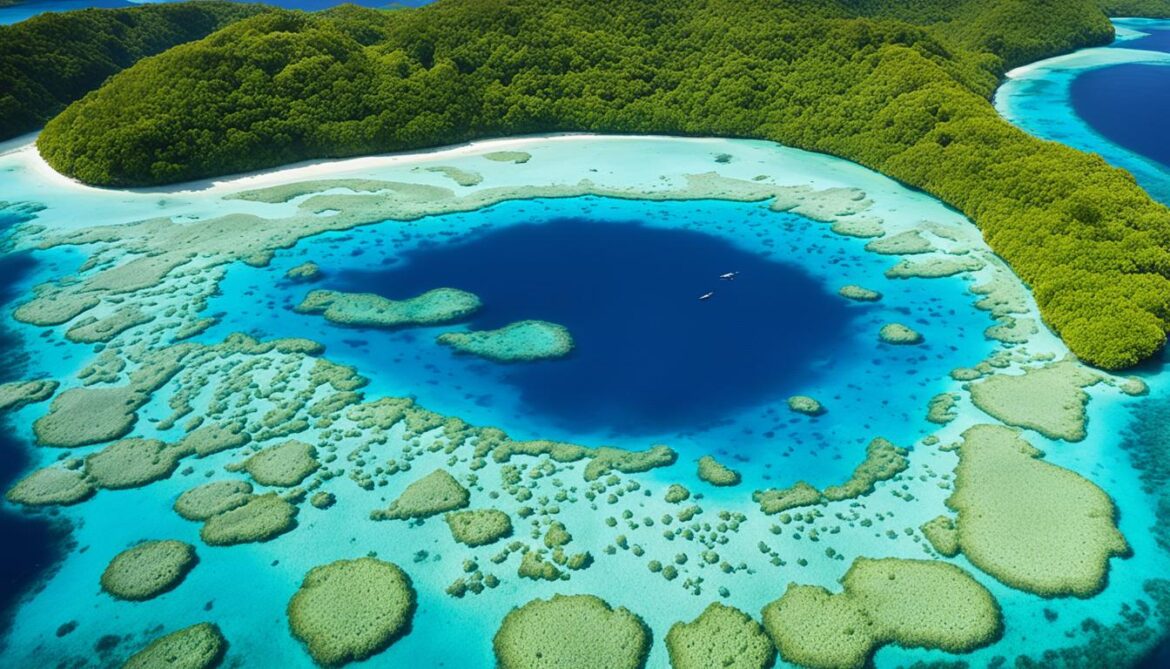
One of the most notable conservation initiatives in Palau is the establishment of the Palau Marine Sanctuary, which was created in 2015. This marine sanctuary covers a vast area of 500,000 square kilometers, making it one of the world’s largest fully protected marine areas. The sanctuary prohibits extractive activities such as fishing and mining, ensuring the preservation of marine biodiversity and the sustainable management of Palau’s marine resources.
The Palau Protected Areas Network (PAN)
Another vital conservation initiative in Palau is the Palau Protected Areas Network (PAN). This network ensures the sustainable management and conservation of Palau’s marine resources through a series of protected areas. Through PAN, Palau aims to safeguard critical habitats, protect marine species, and preserve the ecological balance of its marine ecosystems. The PAN plays a crucial role in maintaining the long-term health and resilience of Palau’s marine environment.
“We believe that by conserving our natural resources, we are securing a sustainable future for the people of Palau and the generations to come.” – Palau Conservation Agency
Sustainable Management and Marine Conservation
Palau’s conservation initiatives go beyond protected areas to encompass sustainable management practices and marine conservation efforts. These initiatives focus on promoting responsible tourism and fishing practices, ensuring that the beauty and biodiversity of Palau’s marine environment are preserved for future generations. By integrating sustainable management principles with conservation efforts, Palau strives to create a harmonious balance between environmental protection and socio-economic development.
Conservation Initiatives in Palau
| Initiative |
Description |
| Palau Marine Sanctuary |
A fully protected marine area covering 500,000 square kilometers, preserving marine biodiversity and resources. |
| Palau Protected Areas Network |
A network of protected areas ensuring the sustainable management and conservation of marine resources. |
| Responsible Tourism Practices |
Promoting sustainable tourism practices to minimize negative impacts on the environment. |
| Sustainable Fishing Practices |
Encouraging sustainable fishing methods to preserve fish stocks and maintain healthy ecosystems. |
| Environmental Education |
Raising awareness and educating the community about the importance of conservation and sustainable development. |
Palau’s conservation initiatives demonstrate the nation’s commitment to preserving its natural heritage and promoting sustainable practices. By protecting critical habitats, preserving marine species, and prioritizing responsible management, Palau is setting a shining example of how environmental preservation and sustainable development can go hand in hand.
Palau’s Sustainable Development Approach
Palau is committed to sustainable development, going beyond its conservation efforts to embrace green initiatives, eco-friendly design, and sustainable land management. The country’s urban development strategies prioritize the integration of green spaces, eco-friendly architectural design, and sustainable infrastructure. By balancing economic growth with environmental stewardship, Palau aims to create a built environment that respects and preserves its natural heritage. Sustainable practices and green initiatives are integral to Palau’s long-term vision for sustainable development.
Palau recognizes that sustainable development is crucial for achieving a harmonious relationship between human activities and the Earth’s ecosystems. It understands that promoting environmental responsibility is essential in preserving the natural beauty of the country, supporting the well-being of its people, and ensuring the prosperity of future generations.
“Our commitment to sustainable development reflects our deep respect for nature and our responsibility as stewards of the environment. Through green initiatives, eco-friendly design, and sustainable land management, we strive to create a sustainable future for Palau and inspire others to follow suit.”
– President of Palau
Palau’s urban planning incorporates the principles of sustainable development by incorporating green spaces throughout its cities and towns. Parks, gardens, and open spaces not only enhance the aesthetics of urban areas but also provide numerous benefits. These include improving air quality, mitigating the urban heat island effect, and providing recreational opportunities for residents and visitors.
Eco-friendly design practices play a significant role in Palau’s sustainable development approach. Buildings are designed to maximize energy efficiency, harness renewable energy sources, and minimize environmental impacts. By implementing sustainable architectural practices, Palau aims to reduce its carbon footprint and create environmentally responsible structures that blend harmoniously with the natural landscape.
Palau’s sustainable land management strategies focus on protecting and preserving natural resources. This includes responsible land use planning, reforestation efforts, and the conservation of critical habitats. By safeguarding its land and ecosystems, Palau aims to maintain a delicate ecological balance while supporting sustainable economic activities.
The integration of sustainable development principles into Palau’s policies and practices reflects the nation’s commitment to addressing environmental challenges and fostering a resilient future. By adopting a comprehensive approach that encompasses green initiatives, eco-friendly design, and sustainable land management, Palau is truly leading the way in demonstrating how a small island nation can embark on a sustainable development journey that benefits both people and planet.
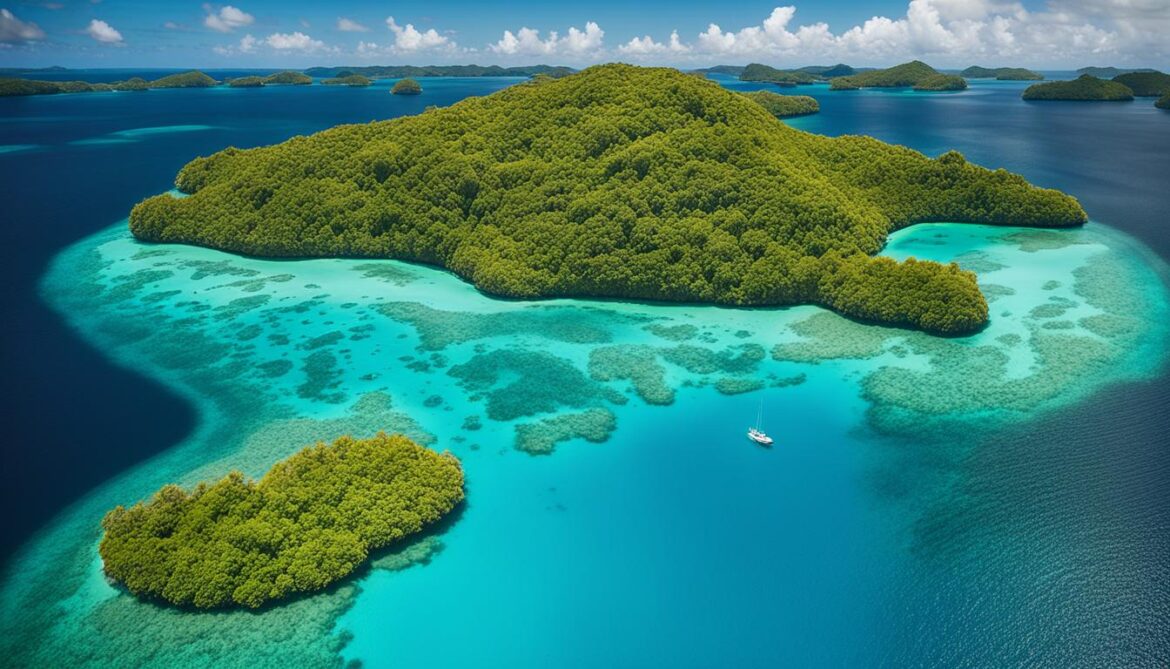
Through its sustainable development approach, Palau paves the way for a greener, more environmentally conscious future. By embracing sustainable practices in its urban planning, architectural design, and land management, Palau sets an inspiring example for other nations to follow. As the world grapples with pressing environmental challenges, Palau’s commitment to sustainable development offers hope and a roadmap for building a sustainable and prosperous future.
Palau’s Impact on Global Conservation
Palau is not only committed to conserving its own biodiversity but also making a significant global impact on conservation efforts. The establishment of the Palau Marine Sanctuary and the country’s conservation initiatives serve as a beacon for marine biodiversity protection worldwide. By setting a precedent for sustainable practices, Palau showcases its conservation leadership and dedication to preserving our planet’s natural resources.
Palau’s role as the host of the Our Ocean Conference further solidifies its position as a global leader in conservation and sustainable development. This international conference brings together leaders, experts, and stakeholders from around the world to address pressing issues related to marine conservation and environmental protection. By participating in such conferences, Palau spearheads discussions on the importance of protecting marine ecosystems and fosters collaborative efforts to safeguard our oceans.
“Palau’s commitment to marine biodiversity protection is commendable,” says marine biologist Dr. Sarah Thompson. “Their initiatives not only ensure the conservation of unique ecosystems but also inspire other nations to take action and prioritize environmental preservation.”
Through advocacy, education, and conservation initiatives, Palau raises awareness about the critical importance of marine biodiversity protection. By promoting sustainable fishing practices, combating pollution, and preserving delicate marine habitats, Palau demonstrates its dedication to the responsible stewardship of our planet’s natural resources.
“Palau’s impact on global conservation cannot be underestimated,” says Dr. Michael Johnson, Director of Conservation International. “Their commitment to safeguarding marine biodiversity sets an example for countries worldwide, demonstrating what can be achieved through conservation leadership and collaboration.”
Table: Palau’s Impact on Global Conservation Efforts
| Initiative |
Description |
| Palau Marine Sanctuary |
An expansive fully protected marine area that serves as a model for marine biodiversity conservation worldwide. |
| Our Ocean Conference |
An international conference hosted by Palau that brings together global leaders to address marine conservation and sustainable development. |
| Advocacy and Education |
Palau actively promotes the importance of marine conservation and raises awareness through various outreach programs. |
| Collaboration and Partnerships |
Palau collaborates with international organizations and countries to implement conservation initiatives and share best practices. |
In conclusion, Palau’s dedication to global conservation is unwavering. Through its marine biodiversity protection efforts, conservation leadership, and hosting of the Our Ocean Conference, Palau sets an example for countries worldwide. By advocating for increased protection of marine ecosystems and raising awareness about the importance of conservation, Palau inspires nations to prioritize environmental preservation and work together towards a sustainable future.
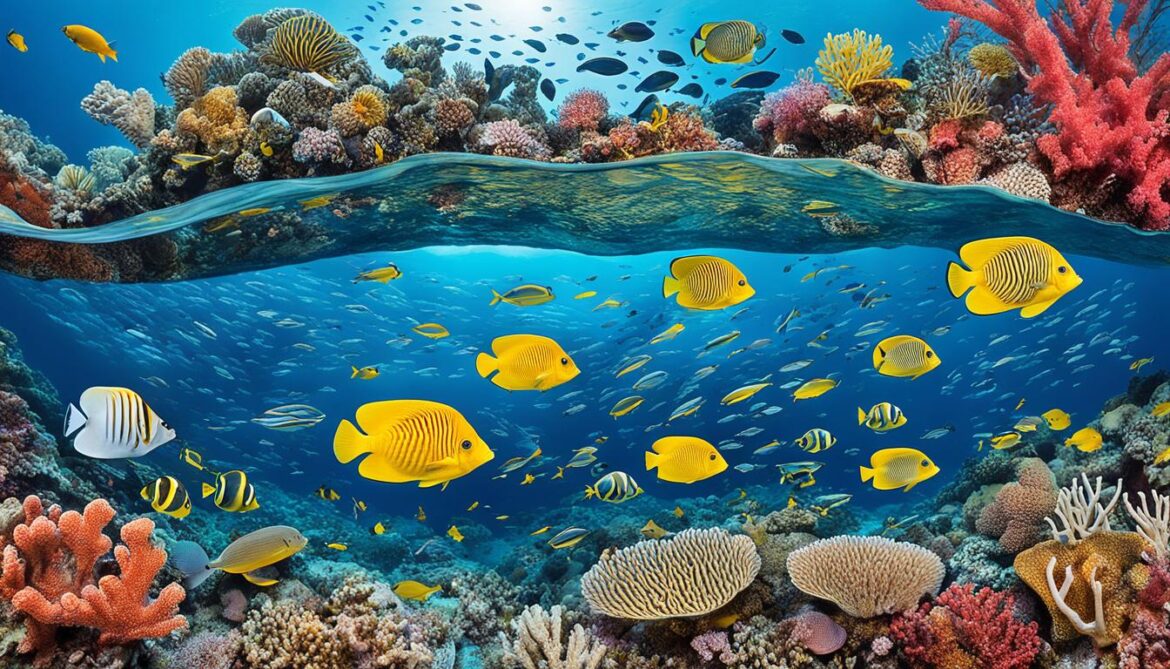
Conclusion
Palau’s sacred natural sites and biodiversity are invaluable treasures that demand our conservation efforts and adherence to sustainable practices. The establishment of the Palau National Marine Sanctuary, the protection of endemic species, and the promotion of sustainable development strategies are vivid demonstrations of Palau’s unwavering commitment to environmental preservation. Through its marine biodiversity protection and leadership in international conferences, Palau has a significant global impact and stands as a shining example for sustainable development.
Preserving Palau’s natural heritage is of utmost importance to maintain the delicate balance of ecosystems and secure a sustainable future for its people. By embracing conservation initiatives and integrating sustainable practices, Palau showcases its dedication to safeguarding its magnificent biodiversity. As the custodians of these precious resources, we have the responsibility to ensure that future generations can experience the awe-inspiring beauty and ecological richness that Palau has to offer.
Inspired by Palau’s efforts, nations worldwide are encouraged to follow in its footsteps and prioritize environmental preservation. This unified commitment towards conservation will have a profound impact on creating a sustainable and resilient planet for all. Together, we can forge a future where biodiversity thrives, sustainable development flourishes, and our collective efforts make a positive difference on a global scale.
FAQ
What are sacred natural sites in Palau?
Sacred natural sites in Palau are areas considered to hold spiritual and cultural significance for the local communities. These sites are often protected due to their cultural heritage and the unique ecosystems they support.
What are Palau conservation areas?
Palau conservation areas are designated regions that aim to protect and preserve the country’s natural heritage. These areas often have specific regulations to limit human activities and promote the conservation of biodiversity and ecosystems.
How does Palau protect its environment?
Palau protects its environment through various measures, including the establishment of marine sanctuaries, the implementation of conservation initiatives, and the promotion of sustainable development practices. These measures aim to safeguard Palau’s natural resources and ensure their long-term sustainability.
What is the importance of sustainable development in Palau?
Sustainable development is crucial in Palau to balance economic growth with environmental stewardship. It aims to create a built environment that respects and preserves Palau’s natural heritage, ensuring a sustainable future for both the people and the environment.
How does Palau practice eco-tourism?
Palau practices eco-tourism by promoting responsible and sustainable tourism practices that minimize negative impacts on the environment. This includes supporting local communities, conserving biodiversity, and raising awareness about the importance of conservation.
What is Palau doing to conserve biodiversity?
Palau has implemented several conservation initiatives, such as the establishment of marine sanctuaries, protected areas, and sustainable management practices. These efforts prioritize the preservation of critical habitats, the protection of endangered species, and the promotion of sustainable practices to conserve biodiversity.
What are the threats to Palau’s biodiversity?
Palau’s biodiversity faces threats from climate change, rising sea levels, habitat destruction, pollution, and urbanization. These factors directly impact ecosystems and species, leading to habitat loss, displacement, and the disruption of delicate ecological balances.
How does Palau address these biodiversity threats?
Palau addresses biodiversity threats through conservation efforts, sustainable development strategies, and environmental protection measures. These include the establishment of marine sanctuaries, the implementation of conservation programs, and the promotion of sustainable land management practices.
What are Palau’s conservation initiatives?
Palau’s conservation initiatives include the establishment of the Palau Marine Sanctuary, the Palau Protected Areas Network, and sustainable management practices. These initiatives aim to protect critical habitats, preserve marine species, and ensure the sustainable use of Palau’s natural resources.
How does Palau promote sustainable development?
Palau promotes sustainable development through various measures, such as green initiatives, eco-friendly design, and sustainable land management practices. It aims to create a built environment that integrates nature, reduces environmental impacts, and supports the long-term well-being of both the people and the ecosystem.
What is Palau’s role in global conservation?
Palau plays a significant role in global conservation through its marine biodiversity protection efforts, conservation leadership, and hosting of international conferences like the Our Ocean Conference. Palau’s initiatives inspire and encourage other nations to prioritize environmental preservation and sustainable practices.
Why is the conservation of Palau’s natural heritage important?
The conservation of Palau’s natural heritage is crucial for maintaining the delicate balance of ecosystems and preserving biodiversity for future generations. It is integral to Palau’s cultural identity, sustainable development, and the well-being of both its people and the environment.

























Post comments (0)